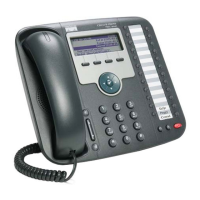2-7
Cisco Unified IP Phone 7931G Administration Guide for Cisco Unified Communications Manager 8.0 (SCCP and SIP)
OL-20798-01
Chapter 2 Preparing to Install the Cisco Unified IP Phone on Your Network
Adding Phones to Cisco Unified Communications Manager
Adding Phones to Cisco Unified Communications Manager
Before installing the Cisco Unified IP Phone, you must choose a method for adding phones to the
Cisco Unified Communications Manager database. These sections describe the methods:
• Adding Phones with Auto-Registration, page 2-8
• Adding Phones with Auto-Registration and TAPS, page 2-9
• Adding Phones with Cisco Unified Communications Manager Administration, page 2-10
• Adding Phones with BAT, page 2-10
7. Requesting the ITL file. The phone requests the ITL file after it requests the CTL
file. The ITL file contains the certificates of the entities
that the phone can trust. The certificates are used for
authenticating a secure connection with the servers or
authenticating a digital signature signed by the servers.
The ITL file is available to the phone only from Cisco
Unified Communications Manager 8.0 and later.
See the Cisco Unified
Communications Manager
Security Guide, Configuring the
Cisco CTL Client.
8. Requesting the
Configuration file.
The TFTP server has configuration files, which define
parameters for connecting to Cisco
Unified Communications Manager and other
information for the phone.
See Understanding Phone
Configuration Files, page 2-5.
See Resolving Startup Problems,
page 9-1.
9. Contacting Cisco Unified
Communications
Manager.
The configuration file defines how the Cisco
Unified IP Phone communicates with Cisco
Unified Communications Manager and provides a phone
with its load ID. After obtaining the file from the TFTP
server, the phone attempts to make a connection to the
highest priority Cisco Unified Communications
Manager on the list. If the security profile of the phone is
configured for secure signaling (encrypted or
authenticated) and the Cisco Unified Communications
Manager is set to secure mode, the phone makes a
TLS connection. Otherwise, it makes a nonsecure
TCP connection.
If the phone was manually added to the database, Cisco
Unified Communications Manager identifies the phone.
If the phone was not added manually to the database and
auto-registration is enabled in Cisco Unified
Communications Manager, the phone attempts to
auto-register itself in the Cisco Unified Communications
Manager database.
Note Auto-registration is disabled when security is
enabled on Cisco Unified Communications
Manager. In this case, the phone must be
manually added to the Cisco Unified
Communications Manager database.
See Resolving Startup Problems,
page 9-1.
Table 2-3 Cisco Unified IP Phone Startup Process (continued)
No. Process Description Related Topics

